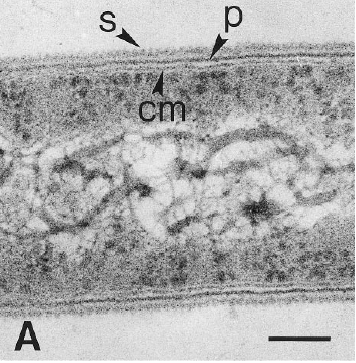Dehalobacter
|
NCBI: |

Classification
Higher order taxa:
Bacteria; Firmicutes; Clostridia; Clostridiales; Peptococcaceae; Dehalobacter
Species:
Dehalobacter restrictus
Description and Significance
Dehalobacter restrictusis an obligate anaerobe, genetically close to the clostridia. It is isolated from soil contaminated with chlorinated industrial products. The bacteria respire using tetra- or trichloroethene as a terminal electron acceptor and dihydrogen as an electron donor.
Genome Structure
No genomes of any species in the Dehalobacter genus have been sequenced to date.
Cell Structure and Metabolism

Dehalobacter restrictus is a nonsporulating, straight, rod-shaped, bacterium with tapered ends. Cells occur singly or in pairs and have one lateral flagellum. They are considered Firmicutes even though their Gram-stain is negative. Electron micrographs confirm the presence of a proteinaceous surface layer (S-layer), which indicates a close relationship with Gram-positive bacteria. It is, thus, considered to be a phylogenetically Gram-positive bacterium, with a Gram-negative cell wall.
Dehalobacter restrictus performs anaerobic respiration using tetrachloroethene (PCE). In a process called dehalorespiration D. restrictus respires by oxidization of dihydrogen (using it as an electron donor) and reductive dechlorination of PCE (uses it as an electron acceptor). PCE is produced naturally in the environment by several species of temperate and subtropical marine algae.
[[Image:dehalogenation.GIF|frame|center| Reductive dechlorination of chloroethenes, starting with tetrachloroethene (PCE), to trichloroethene (TCE), to dichloroethene (represented by cis-DCE), to vinyl chloride (VC), to ethene (ETH).
Ecology
Tetrachloroethene (PCE), also known as perchloroethene and tetrachloroethylene, is a volatile chlorinated hydrocarbon, widely used as a lipophilic solvent, and is one of the most abundant halogenated pollutants. It is widely used for dry cleaning of textiles and degreasing of machine and metal parts. PCE can dissolve fats, greases, waxes and oils off of both man-made and natural fibers, as well as metal parts and other fabricated materials. It is very prevalent in the environment due to poor handling and its resistance to aerobic transformation. It has been released into the environment for decades and has become one of the most common contaminates of soils and groundwater.
Although the government has banned land disposal, PCE is still released into the environment in alarming quantities. In 1993 it is estimated that 11.2 million pounds of PCE was released into the air, and 10,152 pounds was released into the water. Although these numbers are down from previous years, concentrations in the environment are still too high to be considered safe.
PCE is considered a carcinogen, although there is little evidence to truly substantiate this claim, all lightweight chlorinated hydrocarbons are treated as potential carcinogens (although some, such as vinyl chloride, are better documented than others). The carcinogenicity of PCE comes from the interaction of the chemical metabolites with DNA. This occurs when the body attempts to create a more water-soluble compound that can be processed by the kidneys in order to get rid of it. This process usually takes two steps, the formation of an epoxide intermediate, which is then metabolized into a diol, which can be excreted by the body. Epoxides react very aggressively with DNA, and even though they are only around for a very short time, they can create mutations, and when these mutations hit oncogenes, cancer can be induced.
As mentioned above, Dehalobacter restrictus performs anaerobic respiration using PCE. In a process called dehalorespiration D. restrictus respires by oxidation of dihydrogen (using it as an electron donor) and reductive dechlorination of PCE (uses it as an electron acceptor). PCE is produced naturally in the environment by several species of temperate and subtropical marine algae. For the purpose of disposing of PCE, Dehalobacter restrictus is very promising.
Isolation and Cultivation
D. restrictus is isolated from a laboratory system that was being fed with tetrachloroethene.
